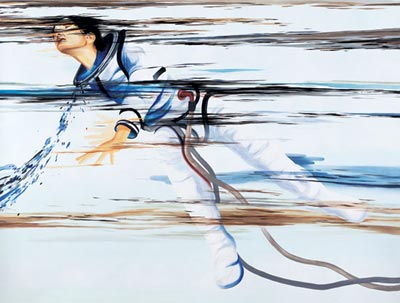Review: Space Is the Placeby Jeff Foust
|
| The exhibition is full of unconventional works of art, most of which are less about space or spaceflight than about using space as a means of critiquing “earthly concerns”, serious or otherwise. |
There’s a mix of all three in this exhibition, although not necessarily in easily recognizable forms. The blue object on the table was an umbilical adaptor from one on the Apollo 17 spacesuits; the table itself was used for autopsies of executed prisoners at the infamous Sing Sing Prison. The juxtaposition of the two, in the mind of artist Ronald Jones, was designed to illustrate the extremes of human endeavor. Without the explanatory text, though, it simply appears to be an odd blue object sitting on an otherwise empty table. The mumbles and grunts are from the audio of the Apollo 11 mission, with all the intelligible words removed; the intent of the artist was to demonstrate how insufficient words are to describe something as spectacular as walking on the Moon. (Although Buzz Aldrin’s two-word description of the lunar landscape, “magnificent desolation”, is both simple and powerful.) And the wine bottles with the speakers? They’re supposed to play space sounds of some kind, but they didn’t seem to be working during a recent visit. Or maybe they were working; it can be hard to tell.
Those are not the only unconventional works of art in the exhibition, most of which are less about space or spaceflight than about using space as a means of critiquing “earthly concerns”, serious or otherwise. A CD-ROM (running on an antiquated Mac, with an obtuse user interface) tries to draw parallels and contradictions between the Space Race of the 1960s and the civil rights movement of the same era. A video tries to link spaceflight to gender politics by reenacting the Apollo 11 landing with a female crew on a Dutch beach; the video, though, is more about the making of the project, with little narration to explain what’s going on. Another artist, Julian LaVerdiere, went to great lengths to contrive a hoax: that in 1942 Wernher von Braun launched a manned V-2 that crashed into the sea, to be “found” by an undersea expedition. His efforts included a documentary-like film and “photos” of the crashed V-2 on the seafloor, complete with Associated Press-style captions. “In a final gesture of humorous defiance,” reads the exhibition’s brochure, “he inserted some of these fabricated images into the Associated Press archive, certain to confound future V-2 and space program researchers.” That sounds less like “humorous defiance” than historical defacement.
There are a few hidden gems (or, rather, things that aren’t that bizarre) in the exhibition. A 12-minute video from a group called Microgravity Interdisciplinary Research shows what happens when you take a group of artists on a zero-g aircraft flight in Russia. (Hint: in weightlessness any old rug can become a magical flying carpet.) Arguably the most famous artist in the exhibition, Laurie Anderson, has a series of photos from a visit she made to Star City during her time as NASA’s only artist-in-residence. The photos of facilities there, though, are small and almost lost among the bigger and stranger installations in the gallery. What “Space Is the Place” shows is that the intersection of space and the arts is more than just conventional spacescapes. What it doesn’t prove, though, is whether any of that additional art is worth viewing.
